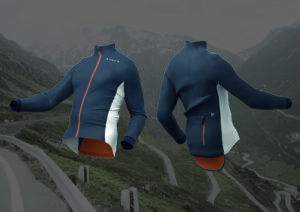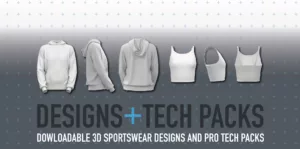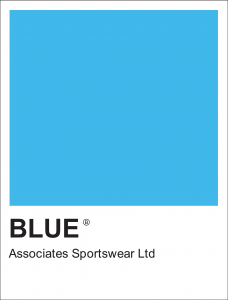Below is a guide to everything you need to consider when starting your own sportswear brand.
What is your niche?
There are very few opportunities left to create a new brand that doesn’t have a niche. Trying to replicate the big established mass-market brands isn’t going to work. There is no way you can compete with their buying power or marketing resource and they have years of brand awareness that you don’t have yet.
Therefore, you need to work out what your brand’s niche is.
Once you have a concept in mind, you’ll need to conduct some market research before taking it any further. This will help you to understand the size of the market and make sure your concept offers something unique and different to existing brands. This is your USP.

Build the brand:
The product is only half the story. Sure, these need to represent your vision and stand up to your customer’s expectations but if you don’t have the brand aspect to your business, you will struggle to convince the public to purchase your product over other brands.
Ask yourself, how many times – consciously or unconsciously – have you found yourself more inclined to buy something because you love the brand it belongs to? This is the power of the brand.
The brand is far more than your logo. This is the starting point of the brand experience but the brand relates to everything the consumer touches or sees about your business. It needs to be 100% aligned to your product and brand strategy but crucially needs to resonate with your target audience and their expectations.
Aspects of Creating the Brand:
There are several aspects to creating the brand. Get these right and the public will be convinced by your product way before they have seen it.
IDENTITY -: This relates to your logo, the look of the website, the look and feel of the product, the photographs, the language and tone you use to talk to your customer.
STORY -: What’s the purpose of the brand. What are you offering your customers that is different? This is how you tell your brand story.
ETHOS -: What are the brand value? What are you hoping to bring to your customers?
PERSONALITY -: Are you fun or serious. Luxury or budget. Whatever sector your brand is in, you need to make sure the personality represents your product and consumers’ expectations.
Everything you put out there should be in keeping with and reflective of the above – from your name and logo to the marketing messages, website copy, packaging, images and social media posts you share.
You really need to really focus on the message you communicate, the emotional connection you want to have with your customer and the type of business you want to build.
Brand Name:
One of the hardest parts of creating a new brand is selecting a brand name. It needs to represent your business, be easy to remember, be easy to search for on google and be unique.
Once you have selected your name, you need to make sure it isn’t already in use and then you need to register this to protect yourself from anyone wanting to knock you off when you are successful.
The next stage is to create a brand logo based on your brand name and the “BRAND” you want to create.
Business Plan:
For any new business, you will need to create a business plan. It’s a key guide for you to follow and make sure you hit your brand goals and business expectations. It’s a great way to work out what capital you will require but also a reminder of what your original vision was and make sure you are still on track.
When you run a brand, many opportunities will present themselves to you, however many won’t be right for your brand but could make financial sense. Having your business plan and referring to this will keep perspective and make sure you don’t take the wrong turn that could damage your brand even though it could increase your turnover straight away.
See our brand start up Pack here
Regulations:
You will need to comply with the Sale of Goods Act, the Supply of Goods and Services Act and the Sale and Supply of Goods Act – which basically dictates that any products you sell must come exactly as you’ve described them.
Your product will need to comply with regulations such as labelling (fabric content, country of origin, care instructions) and flammability, which should represent your product as a whole. You may have a garment made from 2 or more fabrics and the care label needs to represent this as a whole.
Make sure you’re on top of your tax obligations – you’ll need to do your business with Companies House and also decide if you want to register for VAT.
Business insurance provides the protection you will need, not only for theft of goods or damage but also public liability insurance and products liability insurance to ensure you’re covered if a customer makes a legal complaint against you, your business or your clothes.
Finance:
After you have created your business plan and cash flow, you will need to make sure your finances are in place so that you don’t run out of money. If you need to raise finance for your start-up there are several options from Angel investors, Crowdfunding or start-up product funding like a Kickstarter.
Product:
You need to make sure the product represents your brand 100%. Get this wrong and you will spend more time and resources marketing the product because customers are not convinced immediately. If you have a product that is the best it can be, then word will spread and customers will be convinced immediately.
Taking shortcuts or scrimping on this aspect will cost you dearly in the long run. Consumers have the right to return products that don’t live up to their expectations so even if you can convince customers that your products are the best on the market if they don’t experience this then you could end up with lots of returns and worst still, a bad reputation and no-repeat custom.
Sourcing a sportswear factory:
The world is full of factories, all willing to produce your products for a reasonable rate. There are good factories, average factories and terrible factories. The good factories very rarely market themselves as they are always in demand and sell their capacity 6-12 months ahead.
The average and terrible factories will market themselves and it’s pot luck finding a suitable factory that will deliver what you expect. Cost is only one aspect of sourcing your product and so many start-up brands are focused purely on this point, but the cost is negated if the product is late or poor quality.
Finding a factory that can produce to your exacting specifications, on time and at the right cost is key to successfully launching your brand. Getting this wrong or choosing your supplier based on cost alone will ultimately result in disaster.
Fabric sourcing:
Just like the labour that will produce your garment, you need to source in the same manner the fabrics and components that make up your garments. It’s pointless finding a great quality factory and then produce garments made from inferior fabric or components.
Again there are good mills, average mills and terrible mills.
Shipping:
Once your products have been produced, you need to ship these from the factory to your warehouse. You will need to set up an import VAT account and find a freight forwarder that will manage the shipment from the factory to your front door.
Being a start-up, we suggest you work with a small forwarder who is much more hands-on and will guide you through this process rather than run with one of the big corporate giants that will treat you like a number. It may cost you slightly more, but you will be able to pick up the phone and talk to a human about each aspect of your import.
Marketing your sportswear:
Once you have your product, you need to spread the word. Building a website and hope that customers will come won’t work.
You will need to work out a plan that looks after your launch and targets your core customers. The website needs to be functional but represents your brand perfectly.
You will need to create assets to use on your website and social media and also send them to journalists, gear reviewers and bloggers. Again, the quality, look and feel of these assets need to represent what your brand stands for.
The tone of your communication needs to be on point and the copy used on the website and social platforms should complement each other with stories being told on each platform at the same time so consumers gain confidence in your presentation and storytelling.
Social media is becoming more and more important, not only as a messaging tool but as a platform to sell from. What you post, the quality of the image, the language and the tone and story are all key to making sure your customer is engaged and reassured.
Film is becoming much more important. Pictures say 1,000 words but moving pictures with words……
YouTube is the 2nd largest search engine behind Google and google can now pick up words spoken on film and uses these as part of the SEO to make your films visible to anyone searching for these keywords.
Creating a film needs to have a narrative and story attached to it. The film needs a purpose otherwise it won’t be engaging and customers won’t be convinced by this.
Sales:
Work out how your customers will purchase your product. The high street is really struggling and will your product work better or worse than existing brands represented on the high street.
Do you chase department stores, independents or is your route to market all online?
Do you exhibit at events and consumer shows where you could spend the weekend speaking to hundreds of potential customers?
If you’d like support getting your sportswear clothing brand started, contact us today for full support from initial design to marketing.




